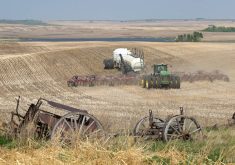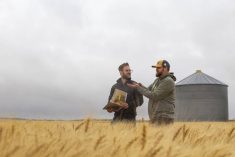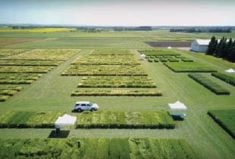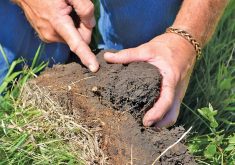Looking over at the emptied room that had been packed with attentive farmers a few minutes earlier, cover crops guru Kevin Elmy could only shake his head.
“If I had given a talk here five years ago, maybe the front row might have been filled — maybe,” the Saskatchewan farmer said after his FarmTech presentation, which had drawn a standing-room-only crowd of 200 or so farmers.
“We’re at a very early stage of it, but the snowball is getting big. It’s growing quite quickly.
“And it’s not just one sector — it’s grain guys, it’s livestock, it’s mixed farms, it’s organic, it’s conventional, people in dry areas, people in wet areas. It’s everyone. They’re looking at the level of inputs we’re using right now and saying, ‘It’s not sustainable.’”
Read Also

Farming Smarter receives financial boost from Alberta government for potato research
Farming Smarter near Lethbridge got a boost to its research equipment, thanks to the Alberta government’s increase in funding for research associations.
Elmy’s jam-packed presentation highlighted both cover crops’ potential and why their adoption won’t happen overnight — the learning curve is as steep as the list of benefits is long.
His 50-minute talk proceeded at a breakneck pace, starting with a primer on soil health basics (from organic matter to mycorrhizae) and ending with a bewildering smorgasbord of choices for the three components of cover crop blends (grasses, broadleaf plants, and legumes).
The latter was an eyeful — three slides each listing 20 different types of cover crops — along with quick pointers on some. Phacelia puts lots of sugar in the soil and so is great for mycorrhizae (the fungi that colonize roots and make nutrients more accessible). Sorghum-sudangrass hybrids can cause cyanide poisoning under certain circumstances. Careful with buckwheat because it goes to seed in 60 days. And what works where, all depends.
“You have to adapt this to where you are,” he told attendees. “If you’re up at Manning and you have cold soils, you’re going to need a different (cover crop) blend than you would if you’re down at Seven Persons.”
There are principles that apply to every situation — “If you don’t keep your mycorrhizae happy, you’re going down a slippery slope,” he warned — but the details are specific to both the conditions on an individual farm and the problem that the farmer is trying to address.
Elmy, who started experimenting with cover crops eight years ago, is the first to admit it’s all rather daunting. And it can be especially challenging for some, he added.
“It depends on how much diversity is already in the person’s rotation, it depends on how healthy their soils are,” he said in an interview. “If you’ve got healthy soils and good rotations, it’s really easy. When you’re dealing with a wheat-canola rotation relying heavily on fertilizer and multiple passes of fungicide, it’s a long process. You can’t buy a solution in a jug.”
The cost-benefit equation
His advice to his audience, however, was ultimately simple: Figure out your goal and then do your research.
The list of ills that cover crops can address is lengthy, and Elmy listed a bunch: building organic matter, improving water infiltration, repairing compaction, boosting microbe levels, drying up wet ground, smothering troublesome weeds, fixing nitrogen, boosting phosphorus levels, and feeding cows (whether your own or a neighbour’s).
There are mixes designed for each (or a combination) of those goals, although most of the available information comes from the U.S. and doesn’t automatically translate to Alberta. Again, you need to zero in on your particular area.
“If you phone me and say, ‘I want to do a cover crop,’ don’t expect me to say, ‘Oh, then you need Blend No. 1,’” said Elmy who sells a variety of cover crop blends.
Along with your goal, it will depend on your soil type, how healthy the soil is, when you’re going to seed it, and whether you’re going to graze, cut, or terminate it.
Elmy first tried cover crops on his seed farm near Saltcoats because he wanted to dry up wet fields. Since then he’s dramatically cut his fertilizer bill; finally got the upper hand on his worst weed (volunteer canola); and has seen big improvements in soil health and structure that means, among other things, easier planting and better germination.
Then there’s the cost-benefit equation.
That’s easier to calculate if you’ve got cows (or access to them) because the feed value of the cover crop can offset the cost of seed (which can vary widely depending on what’s in your ‘cocktail’ mix). For a straight grain operation, the benefits are both harder to measure and further out in the future, Elmy said.
It’s not a ‘do-this, get-that’ process, he said.
“People in the States who have been doing this for a long time say that out of every 10 years, you’ll have five years where it works out well, three years where it works out pretty well, and two where it doesn’t work at all. But those five good years will pay for all 10 years.”
There are a number of companies selling cover crop blends (at least 10, including Elmy, in Saskatchewan and 11 in Alberta), and while Elmy’s orders are growing significantly, he predicts the use of cover crops will take a long time. He spends much of the winter “driving across the Prairies giving talks” and while the crowds are getting bigger, there’s still lots of skepticism.
“A lot of producers just say, ‘I don’t have time for it. I’m busy enough already and don’t need any more work,’” he said.
But the growing interest in cover crops is a strong sign that more and more producers are deciding a different approach is needed for issues such as worsening weed and disease outbreaks, compaction, and poor soil health, he said.
And cover crops are worth the time and effort, he said.
“Any time you do management in an operation, you’re going to increase your returns.”
















